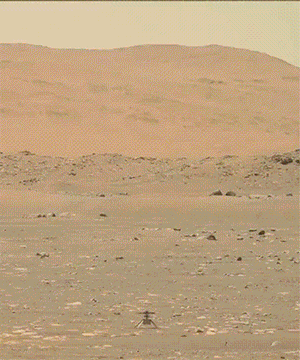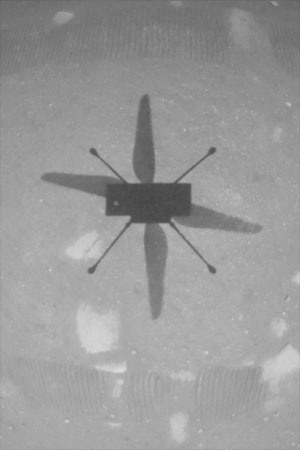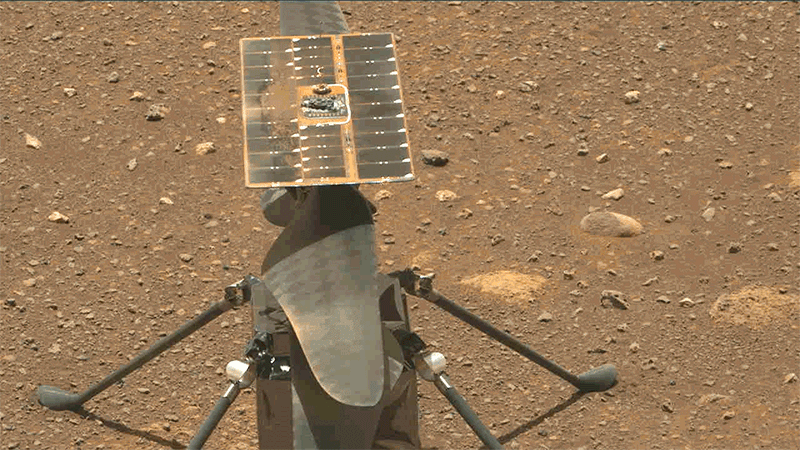 advertisements advertisements
|

|
NASA's Ingenuity helicopter achieves first powered flight on Mars
April 19, 2021 — A small rotorcraft has made both aeronautic and astronautic history, becoming the first vehicle to achieve powered flight on a celestial body other than Earth.
Named "Ingenuity," NASA's first Mars helicopter lifted off from the surface of Jezero crater on the Red Planet at 3:34 a.m. EDT (0733 GMT or 12:33 p.m. Local Mean Solar Time on Mars) on Monday (April 19). Flying autonomously, the 1.6-foot-tall (0.49-meter) aircraft spun up its four carbon blades to climb to its planned altitude of 10 feet (3 meters) and maintained a stable hover for 30 seconds.
Ingenuity then descended and touched back down on its four legs after logging 39.1 seconds in flight.
The Ingenuity Mars Helicopter team at NASA's Jet Propulsion Laboratory (JPL) in Pasadena, California confirmed the flight succeeded after receiving data back from the aircraft via the Perseverance Mars rover at 6:46 a.m. EDT (1046 GMT).
"Altimeter data confirms that Ingenuity has performed its first flight, the first flight of a powered aircraft on another planet!" Håvard Grip, Ingenuity's chief pilot at JPL, announced to the flight team.
The six-wheeled Perseverance served as Ingenuity's data relay and photographer during the flight. The rover, parked a distance away, pointed its camera mast toward an area newly named "Wright Brothers Field," as an homage to Orville and Wilbur Wright, whose Flyer achieved the first-ever powered flight on Earth on Dec. 17, 1903.
"We've been talking so long about our Wright brothers' moment on Mars, and here it is!" said MiMi Aung, Ingenuity's project manager at JPL.
Further extending the connection between the two historic first flights, Ingenuity took to the air with a small swatch of fabric from the Wright brothers' 1903 Flyer. The artifact, which was removed by Orville Wright while restoring the airplane for its first museum display in 1916, was wrapped around a cable under Ingenuity's solar panel.
"Now, 117 years after the Wright brothers succeeded in making the first flight on our planet, NASA's Ingenuity helicopter has succeeded in performing this amazing feat on another world," Thomas Zurbuchen, NASA's associate administrator for science, said in a statement. "While these two iconic moments in aviation history may be separated by time and 173 million miles [278 million kilometers] of space, they now will forever be linked."
In recognition of the flight, the International Civil Aviation Organization (ICAO) — the United Nations' civil aviation agency — presented NASA and the Federal Aviation Administration with the official ICAO designator "IGY" and the call-sign "INGENUITY." The location of the flight was also given the ceremonial location designation JZRO for Jezero Crater.
The fact that Ingenuity was able to take flight was not assured before it happened. The feat was delayed from April 11 after a computer glitch halted a pre-flight spin-up test. Even with the software fix in place, there were still questions if a controlled flight was even possible on Mars.
The planet has a significantly lower gravity — one-third that of Earth's — and an extremely thin atmosphere with only one percent the pressure at the surface. As such, Ingenuity had to spin its two 4-foot-wide (1.2-meter) rotor blades at more than 2,500 rpm to lift the 4 pound (1.8-kg) craft off the surface. (By comparison, a similar craft on Earth would only need 400 to 500 rpm to achieve the same flight.)
As a technology demonstration, Ingenuity carried no science instruments inside its fuselage. Instead, the craft is intended to demonstrate whether future exploration of Mars could include an aerial perspective.
"The X-15 [rocket plane] was a pathfinder for the space shuttle. Mars Pathfinder and its Sojourner rover did the same for three generations of Mars rovers. We don't know exactly where Ingenuity will lead us, but today's results indicate the sky — at least on Mars — may not be the limit," said acting NASA Administrator Steve Jurczyk.
Ingenuity made its first flight on the 16th sol, or Martian day, of its 30-sol (31-Earth day) flight test window. Over the next three sols, the helicopter's team will analyze all of the data from the test and put together a plan for its second experimental test flight, scheduled for no earlier than April 22.
If Ingenuity survives the second flight, the team will consider how best to expand the flight profile.
"History tells us that soon after their first flight, Wilbur and Orville [went] right back to work. They flew three flights that day higher and further than the first one. Like the Wright brothers at Kitty Hawk, we know that our time can make a difference and at Jezero crater on Mars our time is not yet over," said Aung. "This is just the first great flight." |
|

NASA's Ingenuity Mars Helicopter, as filmed by the Perseverance rover, achieves the first powered flight on a world other than Earth on Monday, April 19, 2021. (NASA/JPL-Caltech)

NASA's Ingenuity Mars Helicopter captured this shot as it hovered over the Martian surface on April 19, 2021, during the first instance of powered, controlled flight on another planet. It used its navigation camera, which tracks the ground during flight. (NASA/JPL-Caltech)

Members of NASA's Ingenuity helicopter team in the Space Flight Operations Facility at NASA's Jet Propulsion Laboratory prepare to receive the data downlink showing whether the rotorcraft completed its first flight on April 19, 2021. (NASA/JPL-Caltech) |

The Ingenuity Mars Helicopter's carbon fiber blades perform a wiggle test before the actual spin-up to ensure they were working properly on April 8, 2021, as seen in this video taken by the Mastcam-Z instrument aboard NASA's Perseverance Mars rover. (NASA/JPL-Caltech) |
|

© collectSPACE. All rights reserved.
|
|

|

|
